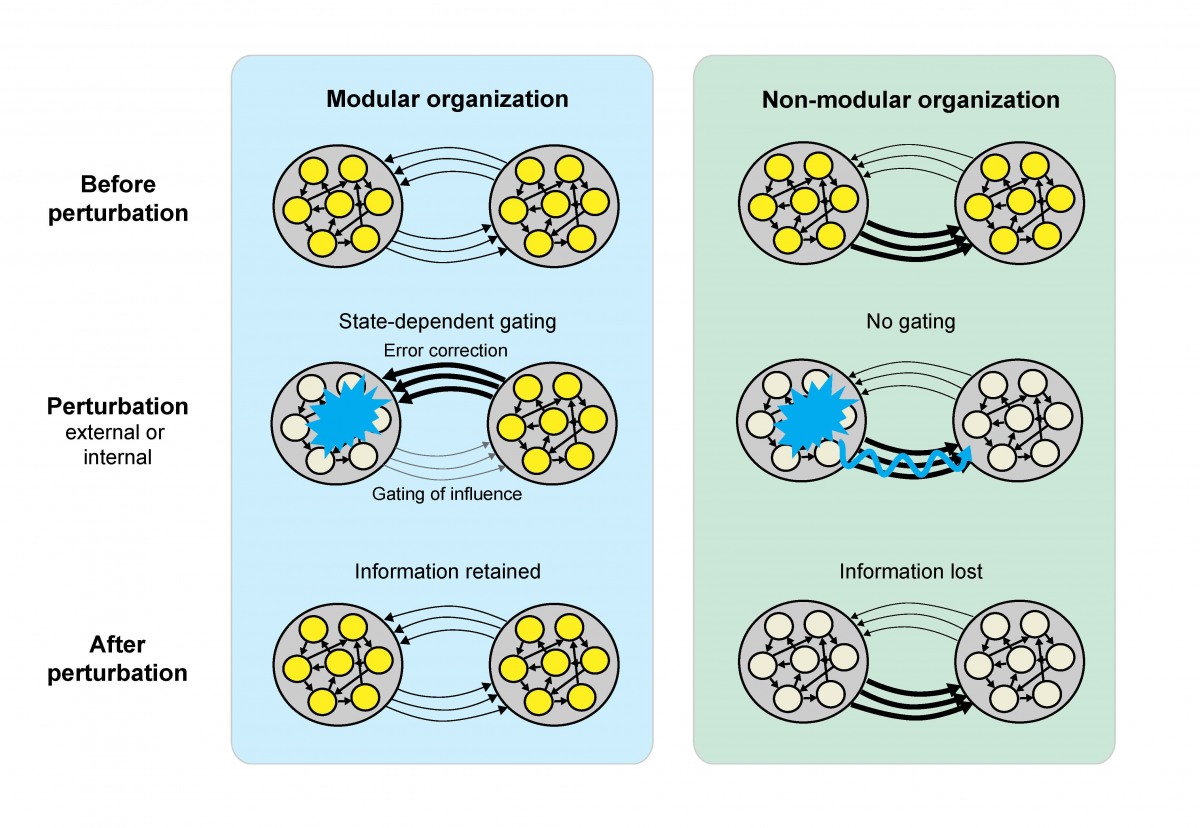Reliable short term memory depends on dynamic safety switches in brain networks

Nicholas Weiler
Most of us know the experience of walking into a room, only to forget what it was we were going to do there, or struggling to keep a new phone number in mind long enough to get it into our contacts.
In a new study, published July 1 in Cell, Wu Tsai Neurosciences Institute member Shaul Druckmann, PhD, and collaborator Nuo Li, PhD, at Baylor College of Medicine, provide new insight into what is happening in the brain to determine whether we succeed or fail in these short-term memory tasks, and why some people (or in the study’s case, mice) may be more forgetful than others.
Decades of research have shown that the brain temporarily stores information in patterns of long-lasting neuronal activity that are distributed across multiple interconnected brain regions.
Scientists believe that this distributed storage of short term memory creates a valuable redundancy: if one part of the brain experiences a disturbance that corrupts the information it was storing, other parts of the brain can act as a back-up and restore the lost information.
But in order for this system to work, the multiple brain regions storing short term memory need to employ some sort of robust coordination to make sure that the good data overwrites the bad, and not the other way around.
In the new study, researchers led by Stanford graduate student Byungwoo Kang and Baylor postdoc Guang Chen, PhD, explored these dynamics in mice trained to briefly remember whether to lick from a spout on the left or the right to get a droplet of water. During the task, the researchers recorded the activity of hundreds of neurons across the animals’ frontal cortices, where short term memories are known to be stored.
In line with prior studies, the researchers observed synchronized persistent neuronal activity in the left and right hemispheres of the brain, which appeared to maintain distinct but parallel representations of the animal’s memory of their task.
 During a short-term memory task in mice, researchers observed coordinated neural activity across left- and right-hemisphere frontal cortex networks. Credit: Chen et al, Cell, 2021.
During a short-term memory task in mice, researchers observed coordinated neural activity across left- and right-hemisphere frontal cortex networks. Credit: Chen et al, Cell, 2021.
The researchers then used optogenetic tools to briefly disrupt activity in one hemisphere or the other to see how these disruptions affected the short-term memory network.
To their surprise, the team found that some mice were notably better than others at protecting their short term memory against experimental disruptions. In some mice, left and right hemisphere representations of the memory seemed to be strictly separated, or “modular”, preventing corrupted information from spreading. Other animals with less independent representations of the memory were much more vulnerable to disruption, leading to more errors in the memory task.
“This is one of the first cases I know of where apparent differences in communication between brain regions can predict individual animals' behavior and performance on a task,” said Druckmann, an assistant professor of neurobiology and of psychiatry and behavioral sciences at Stanford.
To understand how some animals maintained more robust memory storage than others, Druckmann’s team analyzed the patterns of brain activity seen during the task using computational modeling. They found that normally, the different brain regions involved in the memory communicate freely, but when one part of the memory is disrupted the brain is able to detect the change and shut down communication in the network to protect the rest of the memory.

Modeling revealed how dynamic gating of modular memory representations could result in more robust short-term memory performance. Credit: Chen et al, Cell, 2021.
“It was remarkable to see the brain gating the flow of information based on this measure of ‘confidence,’” added Druckmann. “When a brain area had high quality information, it allowed very little influence from other areas, but when it had poor quality information it allowed more input. This makes sense intuitively — if someone tells me something about a topic I know nothing about, I'm more open to changing my mental model than if it's something I'm already an expert in.”“This is similar to modern networks such as electricity grids,” said Li, who is assistant professor of neuroscience and McNair Scholar at Baylor. “They are connected to allow for the flow of electricity but also monitor for faults, shutting down connections when necessary so the entire electrical grid doesn’t fail.”
Notably, the dynamic “gating” described in the new study is not just relevant to protecting short term memory against artificial optogenetic manipulations. Animals with stronger “gating” between memory representations were better at the short term memory task even without any experimental manipulation.
This finding suggests a potentially generalizable mechanism for how the brain dynamically maintains robust short term memory, and why some brains may be better than others at protecting these memories against both external and internal distractions.
Jack Lindsey, a former undergraduate researcher in the Druckmann lab, also contributed to the study.
Funding for this study was supported by the NIH NINDS and BRAIN Initiative grants (NS112312, NS104781, NS113110, EB02871), the Simons Collaboration on the Global Brain, and the Robert and Janice McNair Foundation. Further support was provided by the Whitehall Foundation, Alfred P. Sloan Foundation, Searle Scholars Program, Pew Scholars Program, and McKnight Foundation.